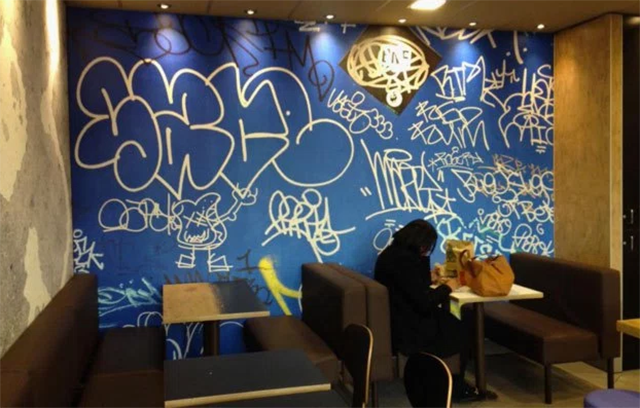Over the last decade, McDonald’s restaurants have been fighting an image problem. Through the likes of a cafe-inspired redesign, to the introduction of the Create Your Taste service, the chain has been using style to deflect from the criticism of its food’s substance.
Most recently, McDonald’s has implemented a graffiti-themed layout in their European restaurants. It’s supposed to serve “to remind people that McDonald’s is a brand of the streets,” says the company’s former chief brand strategist – a scheme expected to draw in a younger, alternative crowd. What it has actually drawn, however, are questions of copyright infringement from the ‘streets’ which the corporation claims to represent.
The company is facing a range of law suits regarding their recreation of particular graffiti styles, as well as some iconic tags. One of the most prominent of these is the tag of controversial international artist Dash Snow, who died in 2009. Snow’s family fears that the depiction of his signature SACE design (pictured below) will tarnish his image as a sensationalist and rebel. The suit also claims that the hundreds of locations now featuring the SACE tag have seen a 9% increase in business since it first appeared, seeming to imply that its presence is at least somewhat responsible.

Tied to the matter of reputation are concerns surrounding money. Several of those suing McDonald’s work as artists-for-hire, and claim that they have lost major contracts due to the unauthorised use of their work. If this is true, the company is responsible for disrupting the livelihood of those it is indirectly celebrating.
McDonald’s obviously didn’t expect such a response, seeming to hold to the old construct of the graffiti artist as an incognito bandit defacing public property as if it were some communal canvas. Today, it’s not unusual to see collections of graffiti showcased in galleries or archived in museums. Like pop art in the day of Warhol, artists like Banksy, Iz the Wiz, and Lady Pink have helped graffiti breach the traditional art market. It’s only natural for the artists to become increasingly protective of their designs and how they are used in response to this sudden valuation. Considering the value of authenticity already present in the medium, such legal battles were bound to break out.
But even if McDonald’s actions are unethical, can artists truly hope to win the war?
In the United States, copyright law is murky when it comes to claiming the design of letters as protected property. That means Snow’s legal team will have to not only prove the SACE tag is iconic, but is distinguishable from any generic graffiti. In the eyes of an American judge, is that difference obvious?
There’s also an issue regarding the legality of the tag’s use. Is a tagger an artist? Does the context of the graffiti’s placement – say, as part of a private commission vs the vandalism of public infrastructure – matter when defining the tag as intellectual property?
These are the questions that will influence not only this case, but set definitive boundaries regarding the rights of the graffiti artist in an age where their work is seeing unprecedented demand. We await the answers eagerly.
